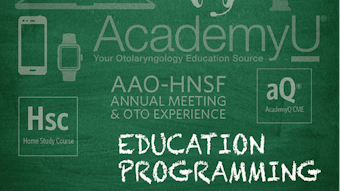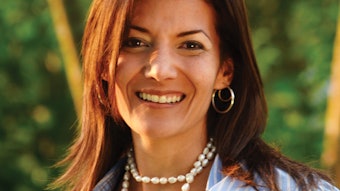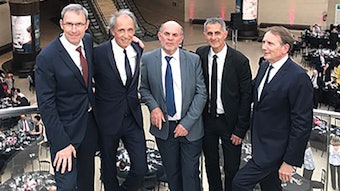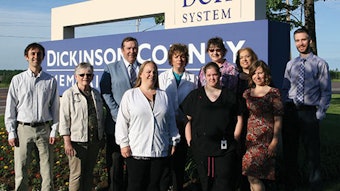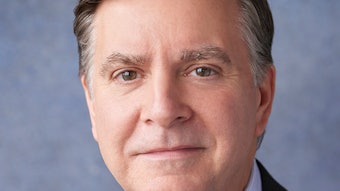Happy 35th!
The merger of the American Academy of Otolaryngology (AAO) and the American Council of Otolaryngology (ACO) that was approved in late 1981 resulted in 1982 being the first year of operation of the successor organization, the American Academy of Otolaryngology—Head and Surgery (AAO-HNS).
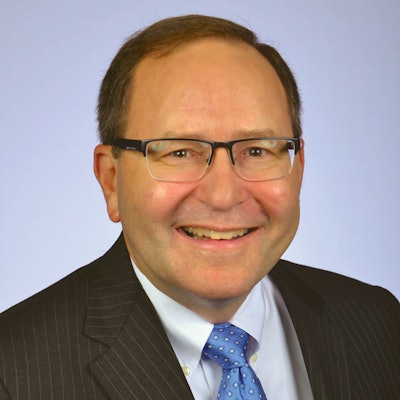 James C. Denneny III, MD
James C. Denneny III, MD
AAO-HNS/F EVP/CEO
Thirty-five years later, the AAO-HNS continues to benefit from the wisdom and foresight shown by the combined leadership of both
progenitor organizations at that crucial time in history. Many of the same issues affecting our members today were also hot topics in 1982. As we approach the year’s last quarter, we celebrate this 35th year of the AAO-HNS, I would like to highlight some of the major happenings within the Academy during that first year, and you will note the special anniversary logo through the year end. I must admit that I was somewhat oblivious to a lot of the activities of the Academy at that time as I was just completing my residency at the University of Pennsylvania.


Loring W. Pratt, MD, was the first president of the AAO-HNS, and Harry W. McCurdy, MD, was the first executive vice president and editor of the Bulletin. The first issue of the Bulletin was published in January 1982. The Bulletin, which succeeded the AAO Perceiver and the ACO Newsletter, published eight times a year during the first few years.
At that time, the Bulletin served as the primary vehicle to educate members as to the operations of the Academy and key issues within the specialty. It also provided a very active classified advertising page.
The Bulletin has continued to be a critical part of the Academy’s outreach to our members as it has evolved over the last 35 years. In Volume 1, Issue 1, the newly approved bylaws are listed. Among these bylaws was the incorporation of a new concept, the “Board of Governors” (BOG). The Academy leaders recognized the need for grassroots participation and representation and demonstrated the foresight of setting up this important structure within the Academy at the beginning.
The organizational meeting and selection of officers was set for the Annual Meeting in October 1982, in New Orleans. At that meeting, Marvin A. Singleton, MD, was chosen as the first chair of the BOG, Robert J. Keim, MD, was chosen as the secretary-treasurer, and Willard E. Fee, Jr., MD, was chosen as the chair-elect. Over the last 35 years, the BOG has increased its scope and representation and continues to be the voice of the grassroots as well as a fertile ground for leadership development within otolaryngology. The Annual Meeting this fall in Chicago will mark the 35th birthday of the BOG!
The Academy transitioned its offices from Rochester, MN, to the Washington, DC, area and eventually into the AMA building in 1982. Jerome C. Goldstein, MD, was chosen as the EVP designate to work with Dr. McCurdy in 1982 and take over in January 1983. At that time, the Federal Trade Commission (FTC) estimated that eight percent of the gross national product was spent on healthcare. Today, we are spending 18 percent on a trajectory toward 25 percent in the next decade. The AAO-HNS had 6,938 physician members in 1982. There were 254 residents in U.S. training programs. Otolaryngologists represented roughly 1.9 percent of all physicians, and there was a reported one otolaryngologist per every 40,000 people in the United States. There were considerable concerns at that time about potential oversupply and mal-distribution of otolaryngologists. The issue of subspecialization was also discussed on multiple occasions in the eight Bulletin issues published in 1982. The primary discussion point was whether head and neck surgery should break away from otolaryngology and form its own specialty. The decision was made not to pursue that path at that time.
Perhaps the most contentious topic of the year revolved around scope of practice issues regarding facial cosmetic and reconstructive surgery. There was considerable acrimony among otolaryngologists against general plastic surgery for what was considered possible restraint of trade issues, which were investigated by the FTC. The AAO-HNS worked with the American Board of Otolaryngology and the American Academy of Facial Plastic and Reconstructive Surgery in negotiations with the American Society of Plastic and Reconstructive Surgeons over a number of years to resolve this problem. Similar issues have continued to crop up over the years involving both physicians and allied health providers over the succeeding decades. The Academy continues to advocate for the best patient care based on training and experience.
As we celebrate the 35th anniversary of AAO-HNS operations, including the BOG and Bulletin, we celebrate the wisdom of our past leaders and can be thankful for our current and future leaders who are willing to donate their time to make things better for their patients and for the specialty.

